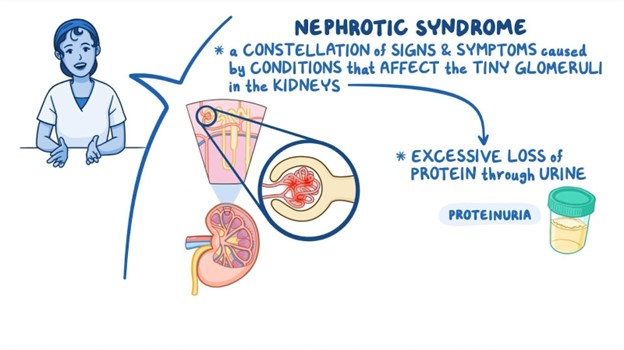A nurse is providing discharge teaching to the parents of a child who has a new diagnosis of diabetes mellitus. Which of the following statements by the parents indicates an understanding of the teaching?
"My son might complain of feeling shaky when he has a low blood glucose level
"My son might have nausea and vomiting with hypoglycemia
Sweating can occur with hyperglycemia
The onset of low blood glucose usually occurs slowly
The Correct Answer is A
A. "My son might complain of feeling shaky when he has a low blood glucose level."
Explanation: Correct Choice. Shaking or feeling shaky is a common symptom of low blood glucose levels, also known as hypoglycemia. When blood sugar drops too low, the body releases adrenaline, causing shaking or trembling. This response is indicative of an understanding of hypoglycemia symptoms.
B. "My son might have nausea and vomiting with hypoglycemia."
Explanation: Nausea and vomiting are not typical symptoms of hypoglycemia (low blood sugar). They are more commonly associated with hyperglycemia (high blood sugar) or other conditions. This statement is not accurate in the context of hypoglycemia.
C. "Sweating can occur with hyperglycemia."
Explanation: Sweating is more commonly associated with hypoglycemia (low blood sugar) rather than hyperglycemia (high blood sugar). When blood sugar levels drop too low, the body can respond with sweating as part of the adrenaline release. Sweating is not a typical symptom of hyperglycemia.
D. "The onset of low blood glucose usually occurs slowly."
Explanation: The onset of low blood glucose (hypoglycemia) can vary. It can occur suddenly, especially if the individual takes too much insulin or diabetes medication, leading to a rapid drop in blood sugar. The correct understanding is that the onset of low blood glucose can be rapid and not always slow.
Nursing Test Bank
Naxlex Comprehensive Predictor Exams
Related Questions
Correct Answer is B
Explanation
A. Apply cool sterile soaks to the child's head.
Explanation: Applying cool sterile soaks to the child's head would not directly address periorbital edema. Nephrotic syndrome is a kidney disorder that results in proteinuria (loss of protein in urine), leading to fluid accumulation and edema. Cooling the head would not have a significant impact on reducing periorbital edema caused by nephrotic syndrome.
B. Apply warm compresses.
Explanation: Correct Choice. Applying warm compresses can help increase blood circulation and promote the reabsorption of excess fluid causing periorbital edema. Warmth can dilate blood vessels and improve the movement of fluids, potentially alleviating the edema.
C. Encourage the child to eat low protein foods.
Explanation: While dietary modifications might be part of managing nephrotic syndrome, specifically encouraging low protein foods may not directly address periorbital edema. The primary treatment for nephrotic syndrome involves medications to control proteinuria and manage fluid balance.
D. Elevate the head of the bed.
Explanation: Elevating the head of the bed is more commonly used to manage conditions like heart failure or obstructive sleep apnea. It might have some impact on overall fluid distribution, but it's not the most effective measure for reducing periorbital edema caused by nephrotic syndrome.

Correct Answer is D
Explanation
A. Assess the bowel sounds:
Bowel sounds are not directly related to the assessment of ascites. Bowel sounds are more relevant in assessing gastrointestinal function and peristalsis. While bowel changes could potentially be a sign of complications, monitoring abdominal girth is more specific to tracking ascites.
B. Frequently ambulate child:
While ambulation is important for overall health, it's not a direct assessment method for monitoring ascites. Ambulating a child might have benefits, but it won't provide specific information about the presence or progression of ascites.
C. Weigh child weekly:
Weekly weighing can provide some information about overall fluid balance, but it might not be as sensitive as measuring abdominal girth when it comes to detecting changes in ascites. Additionally, monitoring weight alone might not give insight into the distribution of fluid in the abdominal cavity.
D. Monitor and measure the abdominal girth.
Explanation: The presence of ascites (accumulation of fluid in the abdominal cavity) in a child with nephrotic syndrome could indicate worsening kidney function and fluid balance. Monitoring and measuring the abdominal girth is a reliable way to assess changes in the amount of fluid accumulation over time. An increase in abdominal girth could suggest a worsening condition.
Whether you are a student looking to ace your exams or a practicing nurse seeking to enhance your expertise , our nursing education contents will empower you with the confidence and competence to make a difference in the lives of patients and become a respected leader in the healthcare field.
Visit Naxlex, invest in your future and unlock endless possibilities with our unparalleled nursing education contents today
Report Wrong Answer on the Current Question
Do you disagree with the answer? If yes, what is your expected answer? Explain.
Kindly be descriptive with the issue you are facing.
